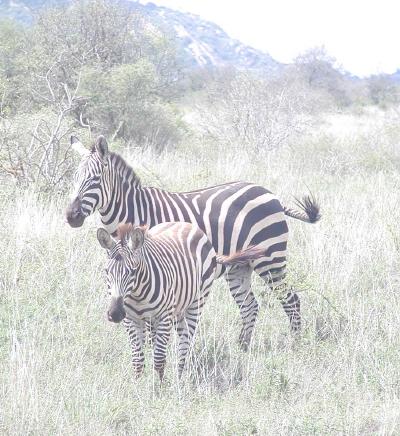2004-02-08 - 9:12 a.m.
This is Part Two of my Kenya diary based on my notes from
my Raptours trip headed by Bill Clark, author of A Field
Guide to the Raptors of Europe, the Middle East, and North Africa as
well as several other leading raptor guides. Visit
right
here for Part One.
Click here for the bird list dated Jan. 11-25, 2004.
Whew. Needless to say, I don't advise anyone to take Lariam
too close to bedtime. The odd reality of the experience was sufficient to cause me
to inquire if there had, indeed, been any earth tremors in the night, which was laughed
off by the rest of the tour participants. Even though I know it didn't -- couldn't have --
happened, it's like a tiny voice inside of my mind is whispering, But it did
happen. A tad creepy.
I'm guessing that something frightened the Ibis away from their roost in the middle of
the night, creating the sounds which inspired the whole dream. After all, unless I
was still hallucinating on Tuesday morning, which didn't appear to be the case, the Ibis
had definitely moved off the roost. But the other elements that seemed so real -- the
balcony door coming open and leading into the starry night, the multiple earth tremors that made
it difficult to walk, perhaps even the impression of getting up and walking around
at all -- were likely all part of the dream.
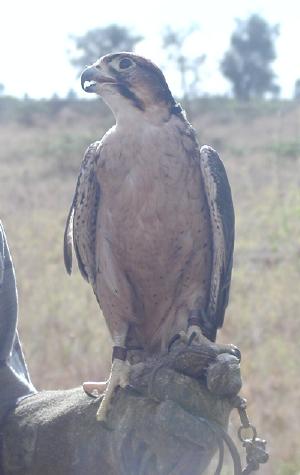
� 2004 by Elaine Radford, all rights
reserved Today we visited Simon Thomsett's raptor aviary.
Among other birds, we met this 16 year old Lanner Falcon female who greatly
dislikes Tawny Eagles -- she was once seriously injured by one -- and the good-looking
4 year old Crowned Eagle pictured
a few entries back to whet your appetite.
Thomsett has been instrumental
in breeding and restoring Crowned Eagles, but he has been almost too successful, since
he could produce more Crowned Eagles than remaining habitat exists for them.
Apparently the future of the forest is quite grim in Kenya, as it is in the U.S., since
there is always an economic incentive to cut down the last tree. It is the same
story the world over apparently, and I was sadly reminded of what is happening back
home in St. Tammany, where I honestly wonder at times if there will be a real
tree standing (and I don't mean a papermill jack pine) by 2030.
For their protection,
Thomsett encourages wild raptors to visit his property, where they will not be
hunted. Indeed, he has domestic doves and chickens running around to feed them,
and we were delighted
to see a wild Lanner Falcon take the bait. It came around and swooped twice before
making a successful third strike. Another wild bird, a Gabar Goshawk, was hanging around
nearby with its entire body language hinting for something to happen, so Thomsett flung
some chicken in the air which it caught expertly. It was
breath-taking to see wild raptors hunting so close. Many more soared overhead,
some quite high. When the captive Lanner Falcon pictured above complained of a Tawny Eagle,
we looked up to see a Black-Shouldered Kite attacking -- yes -- a Tawny Eagle.
It was another day with a huge bird list. Exciting species were everywhere. Hell,
a good-looking male Trumpeter Hornbill was calmly cropping some sort of fruit off
a tree in a gas station parking lot.
Around 5 P.M. we reached Tsavo West. Hornbills (Gray, Von der Decken's, and Red-Billed)
were everywhere. A Secretary Bird was preparing to roost on a branch overhanging
the road, so that we were eye to eye with the bird when we drove up. It stood,
flared in a threat display, and finally removed itself a short distance away, leaving
us in awe of a remarkable bird with its proud head of plume feathers and the
will to display them. We also observed our first African elephant, a lone male
with huge tusks.
We reached the Kilaguni hotel at sunset, where we were given towels and a fruit punch to
enjoy as we overlooked the watering hole complete with Southern Ground Hornbills,
jackals, the ever-unpopular baboons, and impala. My room overlooked the
watering hole from the back porch. I could see Mount Kilimanjaro lost
in the clouds.
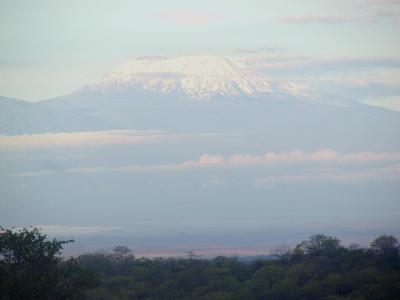
� 2004 by
Elaine Radford, all rights reserved
It was dark by dinner, and we saw some interesting mammals during and
after we dined -- black-backed jackal, African civet, spotted hyena,
swamp mongoose, large-spotted genet. The genet came after dinner when
everyone had left except for me, D., and A. It approached the restaurant slowly,
first perching on a bird feeding station, and finally slinking into the
building. I was thrilled when it checked around my chair for crumbs. It
was house cat sized, and it moved with a sleek catlike grace, but its face
wasn't feline and its tail was positively racoon-ly.
I had trouble sleeping and sat for awhile watching the zebras
approach the pool. The male zebra takes his role as scout and guard
seriously, and if he senses danger, he will not hesitate to bar
the other zebras from moving forward. Impatient baby zebras get sent to the
back of the herd!
New raptors of the day include Gabar Goshawk,
Grasshopper Buzzard, Greater Spotted Eagle, Steppe Eagle, Wahlberg's Eagle,
Martial Eagle (high - we'd get much better views later), Secretary Bird,
Lanner Falcon.
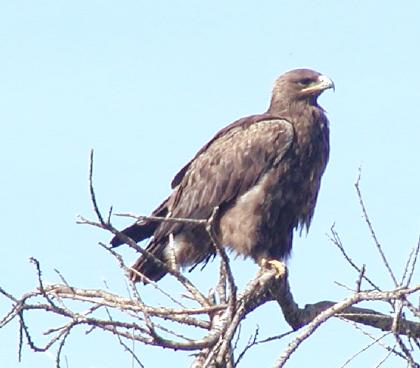
� 2004 by Elaine Radford, all rights reserved
Jan. 14, 2004
At breakfast in the morning, I was favorably impressed by the Common Bulbul who
visited our table, asked me for one crumb of bread, then went to another table
instead of pestering me for the entire slice. He was a remarkably courteous bird
who took care not to overstay his welcome at any one table.
We spent all day exploring Tsavo West, where we encountered four new raptors including
Lizard Buzzard, Shikra, an adorable pair of Pygmy Falcons, and a splendid
Palm-Nut Vulture. Yes, a vegetarian vulture -- well, partly vegetarian, anyway.
Many Palm-Nut Vultures are said to be stained red from their favorite vice,
indulging in palm nuts, but the specimen that we encountered at
our picnic grounds boasted crisp snow-white plumage that set off his handsome
features magnificently.
We visited a dizzying variety of habitats -- passing volcanic cones,
natural ponds or watering holes, even ascending a mountain where I noticed
huge numbers of beautiful butterfly species "hilltopping" in what I'm
pretty sure was a sexual display. The variety of colors was amazing, from orange
to purple. A notable black and white spotted butterfly actually flashed
purple/blue when the light caught it right.
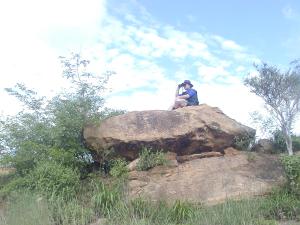
� 2004 by Elaine Radford, all rights reserved
Among other interesting sights, we located a Brown Snake Eagle sitting
guard by his incubating mate. Both birds had to sit low, because
they were being mobbed by a pair of grouchy Common Drongos. We were
to observe that Drongos are the self-appointed watchbirds of Kenya;
without kingbirds or mockingbirds to police the wilds, it's up to the
Drongos to try to move any Eagles out of small-bird territory. For
the most part, the Eagles just pretend not to notice these high-spirited pests.
It was another day with a long bird list that I don't feel like typing out, so
I'll just mention that Hoopoe and Green Woodhoopoe were two of the several impressive
new species that we added.
We arrived back at the hotel in time to enjoy a beautiful sunset with Mount
Kilimanjaro in the background and the busy watering hole in the foreground.
After dinner, and well after dark, a pair of surprisingly huge
Verreaux's Eagle-Owls stopped by for a visit.
Jan. 15, 2004
It was a cool morning with a large influx of Marabou Storks gathered around
the watering hole. Another day in Tsavo West, another huge bird list. The
new raptor of the day was Verreaux's Eagle -- in fact, there were two of them
being harassed by an Augur Buzzard. Not to be left out of the fun, a Tawny Eagle
harassed a juvenile Martial Eagle, which nicely showed off the size difference
between the two species.

� 2004 by Elaine Radford, all rights
reserved
The Long-Tailed Fiscals were gathered into many small noisy flocks. One group
commandeered the middle of the road for what is presumably their mating dance, as
the birds were pairing off two by two as they strutted and wagged their tails.
Impressive birds of the day include Wire-Tailed Swallow, Wattled Starling,
the marvelous Paradise Whydah, the equally marvelous Pin-Tailed Whydah, and
a close look at a Somali Ostrich.
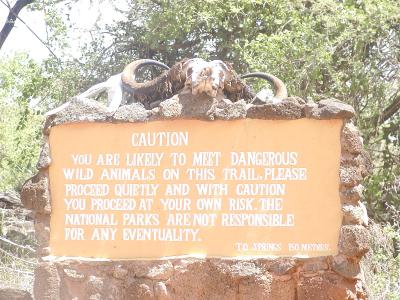
� 2004 by Elaine Radford
We studied a male elephant close to the road, but when D. pointed out the snake coiled
nearby and attention shifted, the elephant became testy and took a threatening
step or two forward in our direction. We had to laugh at the timing. It really
did seem as if the elephant wanted our attention all for himself, although it's more
likely that we'd simply overstayed our welcome.
A sad sighting was a Puff Adder, dead in the road, with a human footprint beside it.
We were destined to see no other snakes while in Kenya. On a happier note, we did
get good looks at Leopard Tortoise, which helped fill out our somewhat skimpy
reptile list.
At dinner, the Verreaux's Eagle-Owl was back, as was the genet, although the
little feline didn't climb up into the restaurant like the other night.
Jan. 16, 2004
We had to join a convoy of other vehicles that were being escorted
through Amboselli National Park, in theory to provide protection from
bandits, although I gathered that the actual risk of banditry is
low and the escort
service is really a sort of jobs program.
It was an extremely wet, slippery day, especially for Kenya's so-called dry season, and,
at one point, a vehicle ahead of us got stuck and had to be maneuvered
out of the mud.
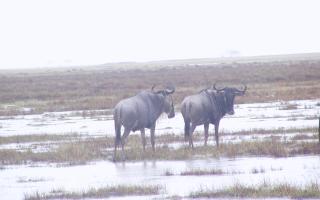
� 2004 by Elaine Radford, all rights reserved
Perhaps the most hilarious sight was an African Fish-Eagle, perched in
the rain, not even trying to think about getting dry, just sitting there
looking hunched and miserable in the gloomy weather.
The new raptor of the day -- even on a wet day like this there had to
be one -- was Ayres' Hawk-Eagle, although it was distant and I'll put this one
in the "better view desired" category for the great if and when I ever return
to Kenya.
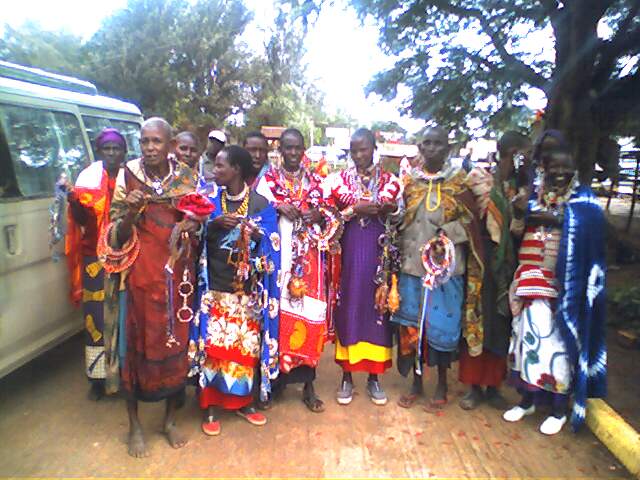
� 2004 by DD, all rights reserved
Poor D. had a small adventure in the marketplace where we anticipated nothing
more exciting than a pit stop. As he descended from the vehicle, a colorfully
dressed older woman asked him to take her picture. He agreed. Perhaps he
should have been suspicious because the instant he got out his camera, a
whole crowd of ladies piled into the picture. Then after he'd already snapped,
the older lady said he was supposed to pay everyone $2 -- each. Does that
ever work? We scooted D. back into the vehicle, and he said he'd pay the head
con artist
$2 but not everyone. When she started to argue, he said he'd just erase the
picture. At that point, she decided she'd better take the $2 and call it even!
I thought the whole point of cell phone pictures is that they were supposed
to be sneaky?
We arrived late in Nairobi too tired to eat and with just enough energy for
D. and I to enjoy a glass of red wine by the crackling fire.
Part One of my Kenya diary can be found
right here. Or move on to Part Three right now.
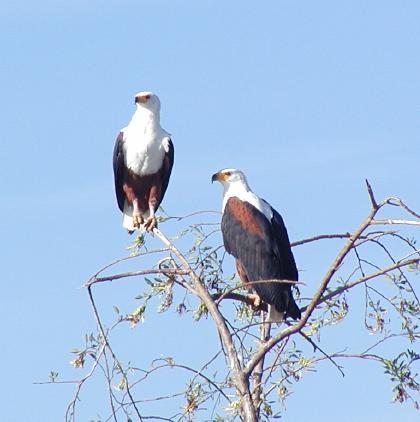
� 2004 by Elaine Radford, all rights reserved
back - next

All Rights Reserved, Copyright 2002-2017 by Elaine Radford
